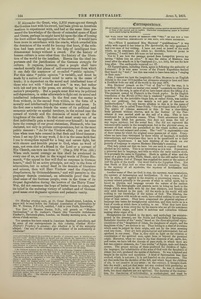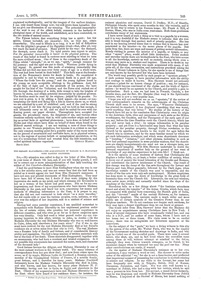
The Wail from the Statue of Memnon – the "Veil" of Isis not a Veil – Potential Immortality of the Soul, and Other Doctrines
Sir,—When I questioned Mrs. Showers’ “qualifications” it was solely with regard to her letter in The Spiritualist, the only specimen I had ever seen of her writing, I have not read or heard of the work which, as its translator, she refers to; therefore, however prone to “jealousy,” I could have felt none on her account.
Nor do I see how the passage quoted from Lempriere proves my having “fallen into an error.” It says the statue of Memnon was vocal after the attack on it by Cambyses (i.e., B.C. 525), but not for how long after. The earthquake occurred B.C. 27.
All Egyptologists, including Birch, agree in following the authority of Letronne. It is true some savans of the French Expedition fancied they heard the “wail;” but this was voted to have been only a “singing in their ears.”
Also, I cannot see how the hospitality of Mrs. Showers to an English Atheist in the year 1872 justifies her strenuous attempt to hoot and hunt a Buddhist from our side of the world in the year 1878.
Mrs. Showers’ remark on the “Veil of Isis’’—“By the way, it is inscribed, ‘My veil hath no mortal ever raised’”—reminds me that there is no veil in the case, in spite of all we have heard about the lifting of it. The garment named by Plutarch is the Greek peplos. In the English translation of the Morals (1704) this is rendered “petticoat.” But the article worn by the inviolable virgin Isis, or rather Neith, was neither veil, nor petticoat, but was merely a red pair of breeches or knickerbockers.* The only known allusion to this is in the name of Neith (Isis), who is called Tesas-Neith, “the enveloped form of Neith.” The peplos of Athense answered to this. It was a close-fitting body garment without sleeves, and in the festival of the Panathenaea it was carried aloft as the sail of a ship. This is here mentioned for a particular reason. When Neith announces that no mortal hath lifted her garment, this does not mean the veil of any vague mystery, but the actual fact. She did not represent the unconceivable nature in the metaphysical, but in the physical sense, on account of that which she personified as the virgin mother, and the wearer of the red raiment and crown. The “veil” is euphemistic—one of those terms by which the original sense passes out of sight. Everywhere we have been victimised by these tricks of language, or modern mis renderings, and everywhere they have to be questioned as to their primordial significance. I am here thinking of the attack on our poverty of language to express Madame Blavatsky’s meaning.
That lady points out that we have but one term to express God and alcohol as two spirits. This is as interesting as it is true. It preserves a primeval fact in language, and tells us where the early namers stood, It is precisely the same in Egyptian. Sheth is spirits of wine and the name of a god who as Set, Sheth, Shadi, and in the still earlier form of Khet (Egyptian God of Things) has supplied the name or the nature of half the gods of the world. Our word God is the Egyptian Khet. Not that Sheth or Khet had no other than an alcoholic meaning. Shet is the mystery of all mysteries, the mystery of fertilisation and fermentation.
Another name of Shet (as God) is step, the mystery, most mysterious, the mystery of fermentation and fertilisation. It was a name of the Nile as such, and applied to the creative or procreating source. The mystery related primally to the genesis of what is called spirit, but is based on physics, and language reveals the nature of the earliest thought. The hieroglyphs and symbols serve to bring us back to the things which were dealt with by the first thinkers, and furnish the only solid foothold in the past. All the words in the world will add nothing to our knowledge of the nature of God. The Hindus, the greatest jugglers with words on earth, have added nothing to our know- ledge of that nature. They have evaporised the physical origines of language into terms for metaphysical subtleties, and then invite us to a feast of words at which there is nothing to eat. What they have done with language is done every day by the insects who eat all the nutriment out of brown sugar, and leave it tasteless and colourless without making white sugar of it.
Metaphysics (as founded in the past), and mythology (as misinterpreted in the present), are the Scylla and Charybdis of Spiritualism. Kabalistic theories of the “souls,” based on the three allegorical representations of the “daughters of Adam, the daughters of angels, and the daughters of sin,” are useless to us. They belong to a class of doctrines which must be judged by their origin, and not by the later meaning read into them. They are both physiological and astronomical, but not spiritual in our sense. That is, they shed no light on the creation or constitution of the spiritual man, apart from or beyond the germinal origin. Moreover, when we come to the four elements of air, earth, fire, and water, we have left the domain of pure myth, in which there are but two creative elements, the “two truths” of Egypt, male and female source. The proper mixing of these produced the children of light; the improper, the cohabitation of the sons of God with the daughters of Adam (the red), produced the spirits of darkness. So was it figured and taught in the myths and mysteries. A kind of Spiritualism was thus evolved, which is not ours; it is not founded on our phenomena. The act that underlies the doctrine of the fall, and which begot the children of sin, is not creative in any sense; on the contrary, it brought death into the world; and yet that same act was credited with producing an order of evil spirits, as in the Book of Enoch. So was it shadowed forth, but these shadows are not spiritual. The doctrine of the destruction, the dissolution of individuality, is mythological, and must be explained mythologically, and by the imagery of the earliest thinkers. I can only assert these things now, but will prove them hereafter. But let me give one illustration of my meaning. The potential immortality of the soul is one of the oldest beliefs, common to the barbaric or aboriginal races of the world, and established, as is here contended, on the two truths of natural source.
The Fijians believe that everything living has a spirit; but few spirits, human included, are immortal; few, as they say, attain immortality. The road to Mbulu is so long, it is so full of difficulties—like the pilgrim’s progress of the Egyptian ritual—that, after all, very few reach the land of promise. Many perish by the way: the diseased, the decrepit, never reach it. No. aged person may expect to arrive. For the potential immortality is based on the physical potency. The result of this belief is found in customs most startling to what we term the more civilised sense. One of these is the compulsory death of the Fijian whilst “strength,” or, as we say, “spirit,’’ enough remains for the journey; and the aged are put to death. Warriors prefer dying in full vigour. So general was this mode of attaining immortality that Wilkes did not find one man over forty years of age in a whole town. The rest had been buried in their belief.** This faith was at the foundation of the Norseman’s desire for death in battle. He considered it shameful to end by what we term natural death in a good old age. “Whom the Gods love die young;” and the young fighters loved to die young, as more acceptable offerings to the goddesses. And, full of the fury of fight and in the plenitude of his power, the hero sought for the kiss of) the Valkyries, and the Norse soul rushed out of life through the doorway of a wide, wide wound to take the heights of heaven by storm, and obtain potential immortality by physical prowess. The doctrine must be read by its origines; judged by its genesis. No new root is given to it by adding a third aspect—the moral—or contemplating our third soul flying like a kite in heaven above us, to which we are attached by a sort of umbilical cord, and if the cord be strong enough, and if our kite fly long enough, and we hold on fast enough, it will ultimately carry us off, and we shall be united for ever with our floating power, our paper elevator. Theosophists have accepted the giants, the pre-adamic races, the daughters of sin, and various other creations entirely mythical, that is, with quite another origin and meaning as actual facts or spiritual phenomena; have done on behalf of the Myths just what others have done on behalf of them when found in the Hebrew sacred writings. I am not making a note of these things to pander to our Western prejudices, but because it is evident to me that the only common meeting point for a possible unity of the races must be on the ground of ascertained and verifiable facts, as in physical science, not in the regions of ancient beliefs or metaphysical speculation, or the use of a terminology filched and wrested from the first intentions, and called spiritual because vaporised.
March 22nd.
* Vide Champollion’s Pantheon.
** Wilkes’ Exploring Expedition. Williams’ Fiji and the Fijians.
Two Madame Blavatskys – Acquaintance of Madame H. P. Blavatsky with Eastern Countries
Sir,—My attention was called to-day to the letter of Mrs. Showers, in your issue of March 8th last, and, if you will kindly permit, I will try to correct one or more misapprehensions of that lady touching the author of Isis Unveiled—Madame Blavatsky.
I had the good fortune to meet Miss Kislingbury when she was in our city a few months since, and was not aware then that she had been so misled as it would appear she had from Mrs. Showers’s statement. I have not seen any printed statements of Miss Kislingbury. They may have been full of errors, but I doubt if they were, judging by the impression she made on my mind, and which remains yet favourable to her as a woman of fine talent and good sense. But as for my own impressions, and those of my acquaintances who have known Madame Blavatsky in the past, and know her now, concerning her means and methods of obtaining information in the East, it is proper to say that she did not rest contented to look about “as a mere traveller,’’ but did reside with or near the various peoples, sects, initiates, or whoever was the subject of her inquiries, and as a student of science and religion.
Having had some peculiar experience, I am qualified somewhat to sympathise with Madame Blavatsky in her unpleasant position under the fire of certain critics, who question her personal experience in different countries, and who even go so far as to throw suspicion upon her very identity. Only last week a letter passed under my eye containing inquiries to this effect, written in Aden, in Arabia:—Is the Madame Blavatsky the real Madame Blavatsky who was so well known in Cairo, Aden, and elsewhere a few years since? For if she is, she must have revived, for the real Madame Blavatsky died at her friend’s residence six or seven miles from that city in 1868. The real Madame was a Russian lady of family and fortune, and of considerable literary ability and reputation. She had a large amount of written materials with her at the time of her death. These materials disappeared, together with an amanuensis, who had been a constant and trusted companion. Is it not possible this amanuensis has assumed the name, rank, and character of the deceased lady?
Good fortune favours the diligent, and Madame Blavatsky is one of the most earnest workers in the literary world. The many columns of correspondence from her pen show that; and now there comes upon the scene, as if by magic, Madame Lydie de Paschkoff, a Russian countess, member of the Geographical Society of France, of a notable family, great fortune, and a traveller for many years. Madame Paschkoff fortunately knew the Madame Nathalie Blavatsky who died in Aden, and also knows, and has known, for many years Madame H. P. Blavatsky, having met her in Syria, in Egypt, and elsewhere in the East. Others of my acquaintance have met Madame Blavatsky in the far East; others have heard of her residence there; for instance, the <... continues on page 7-71 >
Editor's notes
- ↑ image by unknown author. Colored dog
- ↑ The Wail from the Statue of Memnon – the "Veil" of Isis not a Veil – Potential Immortality of the Soul, and Other Doctrines by Messey, Gerald, London Spiritualist, No. 293, April 5, 1878, pp. 164-5
- ↑ Two Madame Blavatskys – Acquaintance of Madame H. P. Blavatsky with Eastern Countries by Rawson, A. L., London Spiritualist, No. 293, April 5, 1878, pp. 165-6
Sources
-
London Spiritualist, No. 293, April 5, 1878, pp. 164-5
-
London Spiritualist, No. 293, April 5, 1878, pp. 165-6



